Photo / Video News & Reviews
Scubaverse Underwater Photographer Interview: Thomas Ozanne
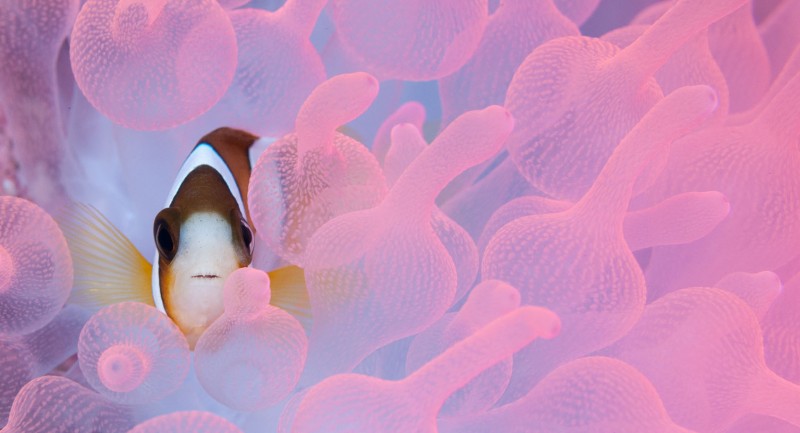
In an ongoing series, Scubaverse.com’s Underwater Photography Editors Nick and Caroline Robertson-Brown talk to underwater photographers from around the world that they admire.
This week’s interview is with Thomas Ozanne.
Nick and Caroline speak to Thomas Ozanne after meeting him at the DEMA show in Las Vegas in 2016.
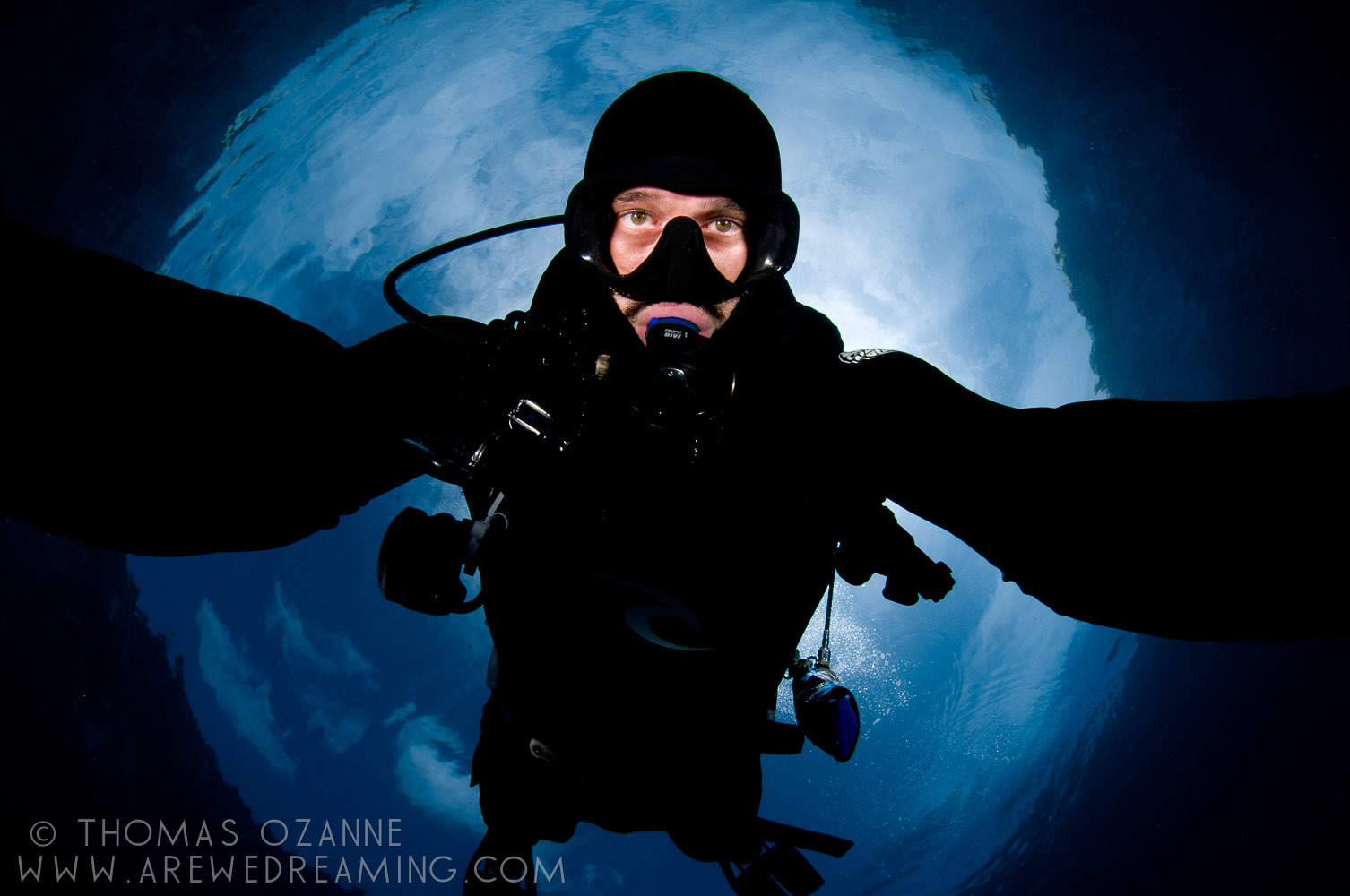
N/C: How did your underwater photography start?
TO: I went on holiday and needed to do something to fill the time so I thought I’d try diving. Fell in love with it immediately. Ended up sticking around much longer than I intended and did my Divemaster course. Almost immediately I landed a job working for the resort I trained with and fairly quickly realised I wasn’t cut out for working the resort reception or taking scuba reviews in the pool. I needed something that could keep me in the water on my own terms and the people I saw around me that had that were making videos, so I took up videography. From there I managed to blag my way in to a job on board a Liveaboard with absolutely no idea what I was doing. After a successful season of shooting videos I realised that it was far too much work (6am till midnight 4 days out of 5 for 6 months) so in the off season I decided to concentrate on shooting stills with my compact camera. I ended up buying an Inon fisheye and close up lenses and a strobe and quickly started getting results I was pleased with. Before too long I realised I hit the limits of the gear I had so decided to sell my video rig and bite the bullet and buy a DSLR set up. After that I took myself off to Sipadan and Palau and shot like crazy. Again with no clue, making it up as I went along. I then made it back to my old Liveaboard and managed to convince the owner to let me shoot photos instead of videos. And based on that I built up a ton of experience diving and shooting. And I think that’s what allowed me to develop my skills and do the kind of work I love to do.
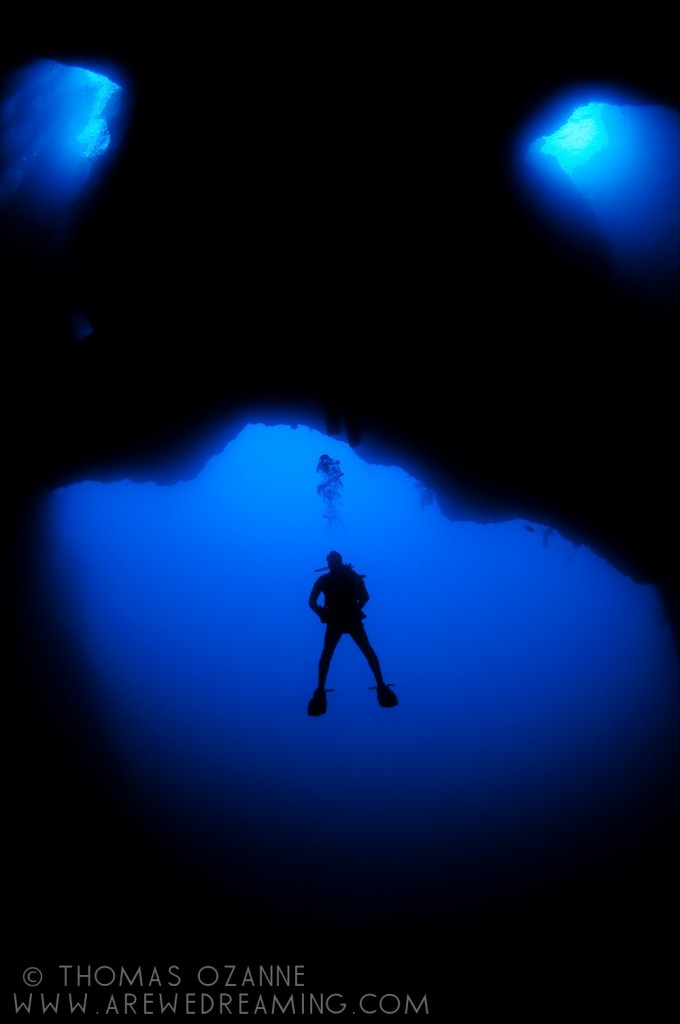 N/C: What is your favourite u/w camera equipment (past & present) & Why?
N/C: What is your favourite u/w camera equipment (past & present) & Why?
TO: Probably top of the list is my Inon 45 degree viewfinder. I had to dive without it once and I was the worst dive of my life. If you buy a DSLR you need to get yourself a magnifying viewfinder of some sort. Craning your neck and squinting through a tiny viewfinder is not going to get you very far.
Secondly I‘d have to say my Tokina 10-17mm fisheye lens. It’s perfect for the way I like to shoot, up close and personal. Super fast to focus and has never missed a beat after being poorly treated for years.
And last but not least would have to be my Subal housings, past and present. They are built like a tanks and just work. No messing around. Thousands of dives and no problems. (Apart from that one time where I wasn’t paying attention during set up and had a slight leak, but that’s totally on me.)
N/C: What would be your advice to anyone new to underwater photography?
TO: Be the best diver you can be. Don’t rush in prioritising the photography if you haven’t nailed your diving, particularly your buoyancy. You’ll stress yourself out, you’ll put yourself and the environment at risk and you will struggle to fully embrace the photography if the diving isn’t second nature to you. That’s it.
Actually there’s more to it than that. Build up lots of diving experience first and then apply the photography. Unfortunately this isn’t always easy, as doing this requires a lot of diving experience that you might not be able to build up if you only dive a handful of times a year. Understandably people want to get on with shooting and maximise every minute of their time under water but I think time spent becoming a good diver will benefit you more in the long run. And without exaggerating too much it could even be the difference between life and death. Diving isn’t an activity to be taken lightly and sadly I see far too many photographers diving like they are invincible. That’s going to bite you in the arse one day.
N/C: What, or who, has been your single biggest inspiration for your underwater photography?
TO: Alex Mustard’s work is a continuing inspiration. He is in a league of his own. Technically and artistically there aren’t many who come close, at least not with his consistency. And Martin Edge’s book was my bible when I started out – I think he owes me some commission for the number of copies I have convinced people they should buy over the years!
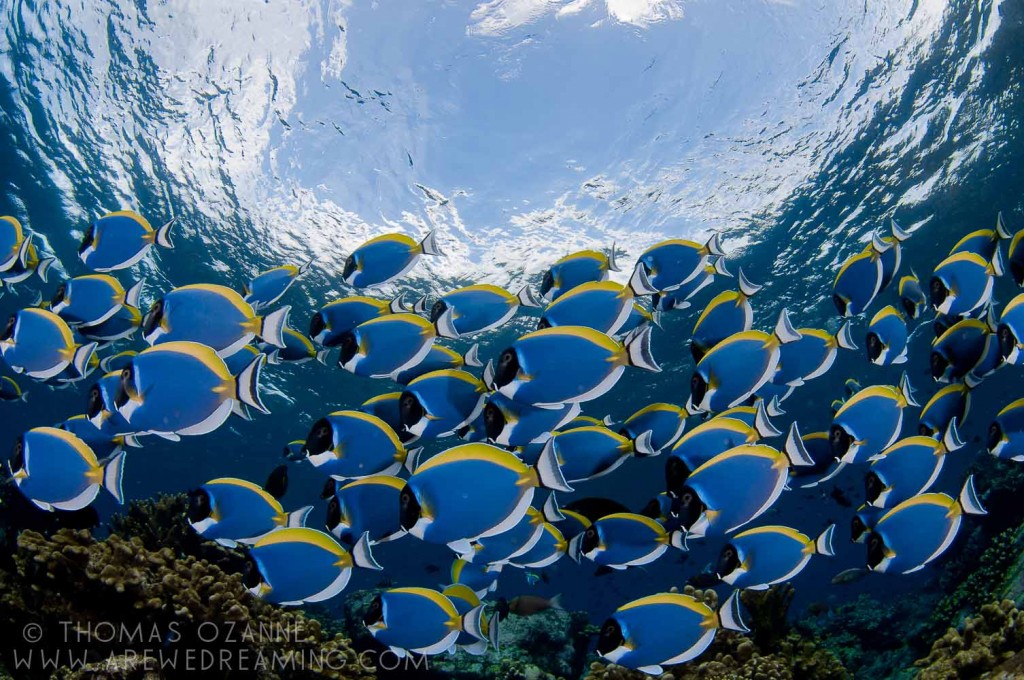
N/C: What are your boundaries on post-editing image manipulation?
TO: I have come to realise that less is more. I never add, and only remove and then only within reason. I don’t use Photoshop, but I think there is a place for it to really polish an image with more control than Lightroom offers. I’m not averse to tweaking the colour of the water column and using dodge and burn techniques with gradients and brushes. And I will not shy away from the spot heal tool to clean up the water column and any of that pesky backscatter, but you are better off learning how to control your lighting than you are spending time clicking away at thousands of sots.
One thing I would say is images need to look natural and balanced. When you are new to post production it’s easy to be a bit heavy handed with your adjustments. I know I was guilty of that when I started. As I have progressed I find myself doing less and less to my images, and I feel this is really the ultimate aim for my photography, to get the shot as best I can in camera and then use the post production to add a final polish to an image. If you spend more time editing images than shooting I think that’s a little back to front. But saying that, skilled use of software to finalise an image is an integral aspect of photography that needs to be embraced. Just be critical of every element of your final image.
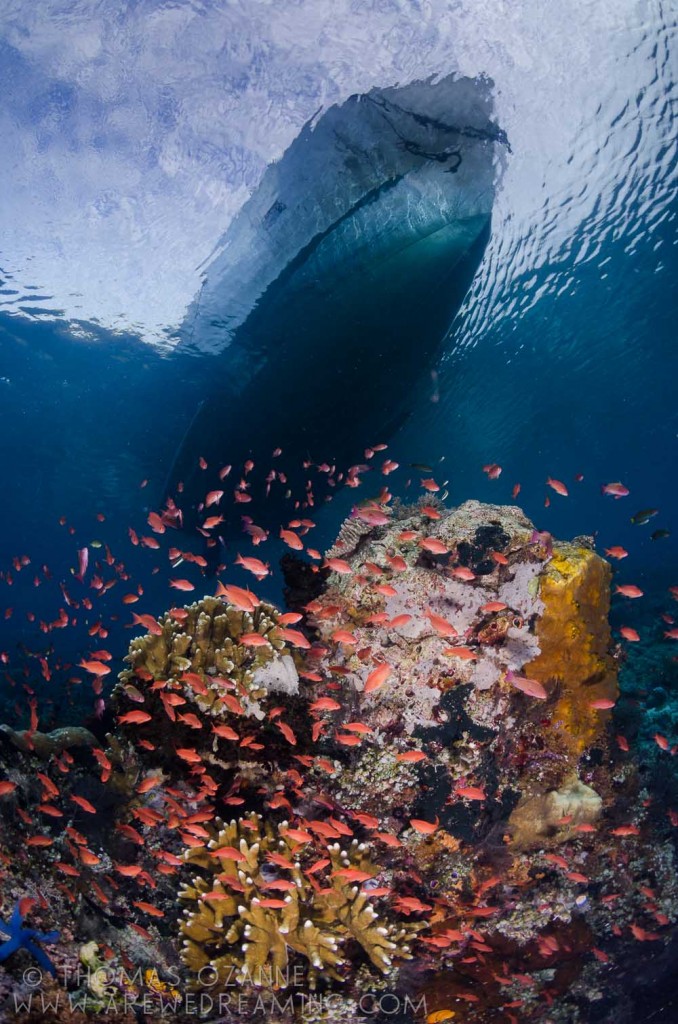 N/C: Where is your favourite dive location, and is it for the photography?
N/C: Where is your favourite dive location, and is it for the photography?
TO: The best diving I have done was in Papua New Guinea. Hands down. Way out in the Coral Sea is an atoll called Easter Fields. It had everything: incredible visibility, amazing pristine corals, huge numbers of schooling fish, and more sharks than I have seen anywhere else (sadly that’s an indictment of the impact humanity has had on sharks more than anything else, in all my diving in Asia I have seen hardly any sharks). And a close joint second comes Palau, Raja Ampat, and Komodo. All incredible places.
N/C: What are you views on marine life manipulation, moving subjects?
TO: Honestly I can’t say that I haven’t encouraged a few creatures to move slightly using a finger or a poker in the past, never actually touching, just corralling gently, but even that is something I have come to feel is unacceptable. I don’t think manipulation has a place in wildlife photography. We are representing nature, and nature doesn’t exist for our convenience. I regularly see shots that most reasonable people could tell are not natural and couldn’t have been achieved without interference. We know the shot must have been gotten with dubious methods, and so does the person that took it, and they have to live with themselves. But then that’s one of the problems isn’t it? Those kind of people just don’t care. They’ll lap up the praise regardless and continue to exploit nature for their own ego.
Over time I have come to realise that my photography is opportunistic. I shoot things that happen in front of me. I don’t want a shot in my portfolio that would never have happened without deliberately interfering with a creature.
That people proudly display such images and even win awards for them occasionally is a shame, and I’m glad that often judges of competitions are hard on an image when this kind of behaviour is suspected. But saying that, some still slip through the net.
N/C: What do you look for when you are making your images?
TO: A nice composition. More than anything else a well composed and structured image is what I look to get. Having complete control of your buoyancy allows you to position yourself in the water column and a decent viewfinder on your housing will allow you to consider every square mm of the frame. One thing that stuck with me from an old teacher of mine was the idea that if something isn’t adding to an image it is taking away. He was referring to design in general but I find is a great thing to keep in mind when shooting images. Everything in your image should be there for a reason. Consider the foreground and the background. Of course there is the subject to consider but don’t forget the horizon, the sun’s position, Snell’s window, the blue gradient of the water, the clouds in the sky, the silhouette of the reef…. all of these elements are yours to control with your positioning in the water. At least for wide-angle they are. For macro it’s all about the subject and a clean or interesting background as something to aim for.
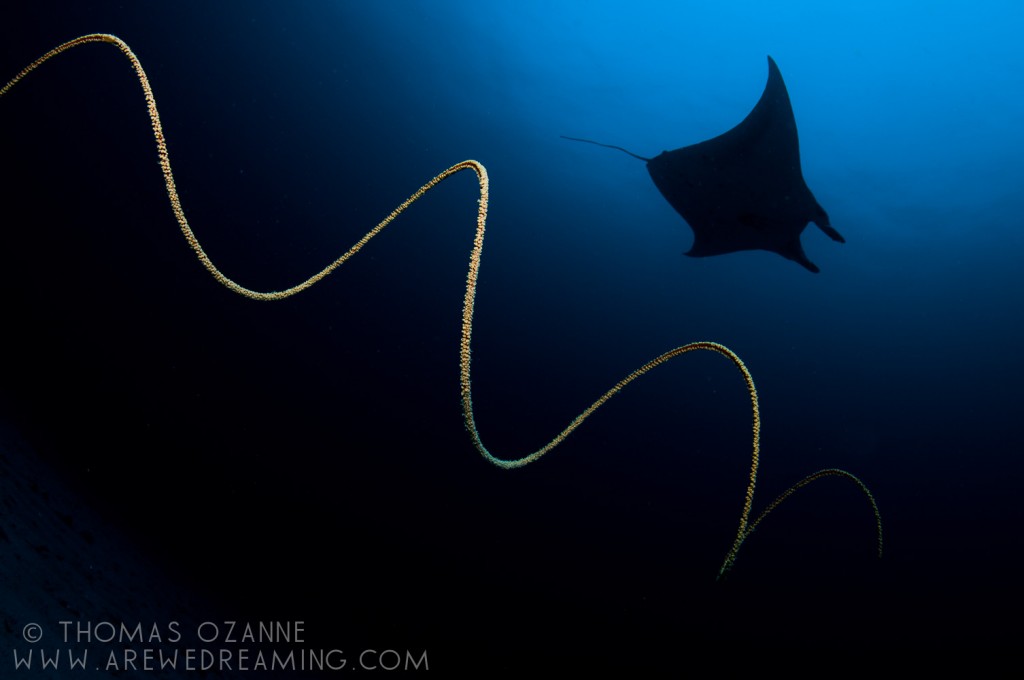
N/C: What motivates you to take u/w photos?
TO: New experiences, and continuously striving to improve my photography. I really enjoy getting wows out of people. And the shots that seem to have that effect are shots that were taken when I myself was thinking “wow, this is so cool”. I love the adventure of diving and the beauty of nature and the skill of good diving and photography and I love that there is always something new to see, something new to learn, and more amazing images to be captured with improved technique.
N/C: If you could photograph any one thing/place what or where would that be?
TO: High on my list is more big stuff, and I guess the ultimate would be whales. A trip to Tonga to meet the humpbacks is calling to me. That and working more with models. I have had some great experiences shooting free divers and intend to do more. I love the sport of free diving and there are some very cool images to be made with the right collaborations.
I just re-read the question and see that you said “any one thing”, so I guess I’ll have to choose. It’s going to have to be whales, isn’t it?
See more of Thomas’ work at www.arewedreaming.com. Find him on Instagram at @arewedreaming
Blogs
Jeff Goodman Launches Underwater Moviemaker Course with NovoScuba

Transform Your Dive Experiences into Cinematic Masterpieces
NovoScuba has partnered with acclaimed underwater filmmaker Jeff Goodman to introduce the Underwater Moviemaker Course—a revolutionary program designed to equip divers with the skills to capture the breathtaking beauty of the underwater world.
Whether you’re an aspiring filmmaker, an avid diver, or a photography enthusiast, this course offers the tools and expertise needed to create stunning underwater videos. From vibrant coral reefs to curious marine life, you’ll learn how to film, edit, and produce captivating underwater stories, all with expert guidance from a seasoned professional.
Jeff Goodman: A Legacy in Underwater Filmmaking
Jeff Goodman brings over 40 years of experience in underwater film production for television to this course. Reflecting on his career, Jeff said:
“Although technology has dramatically changed, the basics of underwater filming remain constant. This course covers crucial skills for producing great videos. Whether you’re creating professional broadcast films or high-quality hobby videos, the fundamental principles are the same.
A camera operator must master their equipment to capture those magical underwater moments effortlessly. But beyond technical know-how, underwater filmmaking is about having fun and enhancing your diving experiences. So, take your time, learn at your own pace, and enjoy this creative journey.”
About NovoScuba
Founded in 2023, NovoScuba is reshaping dive education with a comprehensive, digitally native platform. Offering cutting-edge training programs for divers at all levels, NovoScuba sets a new benchmark in the diving industry by combining innovation with accessibility.
With ISO-certified courses, a student subscription model, and multilingual support, NovoScuba ensures that dive education is inclusive and engaging. More than just a training provider, NovoScuba fosters a global community of divers committed to exploration, collaboration, and sustainability.
Join the NovoScuba Underwater Moviemaker Course Today!
Dive into the world of underwater filmmaking and start creating cinematic stories that inspire. Learn more about the course and enroll today at www.novoscuba.com/novoscuba-underwater-moviemaker-course.
EXCLUSIVE: Jeff Goodman interviews Mark Spiers, CEO of New Scuba Diving Training Agency NovoScuba
NovoScuba’s Game-Changing Approach for Dive Store Owners: WE PAY YOU!
The diving world thrives on passion and adventure, but for many dive store owners, the financial and operational challenges can be as deep as the ocean.
NovoScuba, an emerging force in the diving world, is on a mission to transform this landscape for the better. With a revolutionary approach to dive store and training agency partnerships, NovoScuba is setting new standards for how dive stores can thrive while keeping their focus on delivering exceptional diving experiences.

A New Paradigm: NovoScuba’s Bold Mission
NovoScuba’s mission is straightforward yet profound: to disrupt the traditional dynamics between dive store owners and training agencies. Traditionally, dive stores have been subjected to substantial fees charged by training agencies, for membership, materials and certifications. These costs have often placed a heavy financial burden on store owners, cutting into their profits and limiting their ability to offer competitive prices to customers.
NovoScuba flips the script by offering a model where dive stores earn money, instead of paying high fees. Dive stores receive commissions for every student they register, and their certification costs are covered. This new model not only boosts profitability but also ensures clients get top-quality training at unbeatable prices.
Financial Upsides: Earn From Student Registration
NovoScuba’s approach is simple yet revolutionary. Dive stores partnering with NovoScuba can earn commissions for every student they enroll.
Here’s how it works: For every student enrolled through NovoScuba, dive stores receive a commission. Each student enrolled will receive their e-learning materials and certification credit included in their subscription. This arrangement is a significant departure from the traditional model, where dive stores often struggle to manage high overhead costs related to training fees and certification expenses.

NovoScuba’s approach ensures that dive stores can focus on what they do best—providing top-notch diving experiences—without being bogged down by excessive financial burdens, and the need to carry large stocks of materials.
Quality Training at a Great Price
NovoScuba stands out by offering high-quality, ISO certified, training that doesn’t break the bank, in fact our students will pay less than with most competing agencies. Clients benefit from top-notch education and safety standards at competitive prices. Dive store owners can confidently promote NovoScuba’s programs, knowing they’re offering fantastic training at affordable rates. This balance of quality and affordability helps dive stores build a strong reputation and attract more customers.
Your Brand is Your Business: NovoScuba’s Commitment to Showcasing Your Identity
At NovoScuba, we understand that your brand is your most valuable asset, and we’re committed to putting it front and centre. Unlike agencies that charge high fees to promote their own brand, we believe in investing in yours. With NovoScuba, you won’t be paying to advertise someone else’s logo alone, — our focus is on showcasing your unique identity. Certifications prominently feature your brand, as well as the training agency, reinforcing your store’s image and brand every step of the way. We’re here to support and elevate your brand, ensuring that your investment directly benefits your business.
Affordable Membership: An Investment in Your Success
NovoScuba’s membership model is designed with dive store owners in mind. Membership fees are kept low and include annual Pro member fees for your team. Payment can be made monthly or annually in your local currency, avoiding the hassle of exchange rate fluctuations. NovoScuba promises no exchange rate changes without a six-month notice, ensuring financial stability and simplifying budgeting. With a membership lasting 12 months from date of joining, you’ll enjoy a full year of NovoScuba’s benefits and support.

Streamlined Operations: Simplifying Your Workload
Handling administrative tasks can be a challenge, but NovoScuba makes it easier. We’ve streamlined certification procedures and reduced paperwork to help dive stores operate more efficiently. Certification processing is quick and straightforward, allowing more focus on teaching and customer service. Our system minimises bureaucracy by storing necessary forms in student profiles, reducing paperwork and administrative delays.
Crossover Made Easy
For dive stores looking to transition to NovoScuba’s model, the crossover process is designed to be smooth and hassle-free. NovoScuba provides support to ensure that the transition is as seamless as possible, helping dive store owners integrate into the new system with minimal disruption. Experienced dive Pros don’t need to undergo extensive retraining. Our crossover is designed to familiarise Pros with NovoScuba’s user-friendly platform, standards and course structures, and not to waste time and expense re-training in water.
With just a few simple steps, you’ll be ready to offer top-notch training through NovoScuba.
Comprehensive Business Support and Training Included in Your Membership
NovoScuba goes beyond financial benefits by offering experienced support and training. This value added service includes:
- Business Training: Optimise your operations with guidance on marketing, customer service, and best practices.
- Marketing and Promotion: Access resources to attract new customers and boost your store’s visibility. Enjoy cross promotions with NovoScuba to gain increased exposure.
- Ongoing Support: NovoScuba’s commitment to its partners extends beyond initial training and setup. The company offers ongoing support to address any issues or questions that arise. This continuous support ensures that dive store owners have a reliable resource to turn to whenever they need assistance.

Embracing Digital Natives: Instant Evolution and Continuous Improvement
NovoScuba’s digital-native approach is a game-changer. Leveraging cutting-edge technology, we ensure our services evolve and improve swiftly. Dive stores benefit from instant updates, the latest features, enhancements, and effective solutions, keeping them ahead of the curve. This continuous improvement helps dive stores stay competitive and deliver exceptional services. Whether it’s a new course update, additional marketing resources, or improved e-learning functions, NovoScuba’s digital infrastructure ensures that dive stores are always equipped with the most current and effective solutions. This continuous evolution not only helps dive stores stay ahead in a competitive market but also ensures they consistently provide top-quality services to their clients.
Why Is NovoScuba Doing This? – Fair Profit Sharing for Greater Access and Growth
At NovoScuba, we’ve taken a bold step by paying commissions to stores rather than following the traditional model of training agencies charging high fees. Our mission is to make diving accessible to everyone and to foster a growing community of new divers and continued education. By redistributing profits more equitably between stores and training agencies, we aim to create a more supportive and collaborative environment within the industry. We believe this approach not only helps individual stores thrive but also stimulates overall growth and innovation in diving. Our commitment to fair profit sharing reflects our dedication to the long-term health and expansion of the diving community.

Everyone is getting a piece of the pie.
Getting Started: Join the NovoScuba Revolution
Ready to revolutionise your dive store experience? NovoScuba is here to support your journey toward reduced costs, increased profitability, and enhanced operational efficiency. Get in touch with our team to learn how NovoScuba can transform your business.
For more information, email info@novoscuba.com or visit www.novoscuba.academy.
Blogs
The Benefits of Underwater Photography Workshops

Are you just getting started out in underwater photography or are you a seasoned shooter who wants to take their images to the next level? Whatever you experience or ability, here’s an overview of underwater photography workshops.
What is an Underwater Photography Workshop?
The first thing to note is that this is not ‘school’! There are no compulsory classes and at workshops you are free to pick and choose what you take part in, or otherwise.
A huge part of learning and developing your skills is through experimentation, trial and error, responding to feedback, and honing your technique. Underwater photography workshops provide you with the perfect platform for practice and improvement.
There is no better alternative to hands on experience in an environment that is 100% dedicated to your development. Reading informative articles and watching videos on YouTube can never replace the value of one on one time with your camera rig, underwater!
Underwater photography workshops are generally structured around core components, namely: presentations, underwater practice, feedback and critique sessions, troubleshooting/one-on-one sessions, and technical support.
Other components of a workshop include dining, relaxing, and time for socializing too!

What Topics do Underwater Photography Workshops Cover?
Depending on the pro, the type of workshop and regional diving highlights, a wide range of topics may be covered from composition and lighting through to shooting techniques and editing.
Benefits of an Underwater Photography Workshop
- Improve Your underwater photography
- Learn from professionals
- Learn from other participants
- Expand your photography knowledge and understanding
- Try put new techniques
- Learn how to maximize your camera rig
- Phenomenal travel opportunities
- Memorable experience and new friendships

Underwater Photography Workshops in the Lembeh Strait, Indonesia
When it comes to underwater photography workshops that focus on shooting macro, muck diving, and unusual marine species, there can be no better destination on the planet than the Lembeh Strait.
The Critter Capital of the World, a Muck Diving Mecca, and the Twilight Zone are just a few of the names that have been given to this stretch of water over the years due to its high density, and diversity, of rare and unusual marine life.
Some of Lembeh’s most iconic species include the hairy frogfish, Pontohi pygmy seahorse, the Lembeh sea dragon, Mandarin fish, Bobbit worms, Rhinopias scorpionfish, flamboyant cuttlefish, tiger and harlequin shrimps, ornate ghost pipefish, harlequin crabs, and where do we start with octopus? Here’s just a few… wunderpus, mimic, blue ring, hairy, long arm, starry night, and coconut… and the list goes on!
Dive conditions in the Lembeh Strait can be extremely favourable for underwater photographers. There is little to no current making both moving around and remaining stationary a breeze. The comfortably warm water temperatures reduce the cold that can also set in when not on the move.
Lembeh Resort and Underwater Photography Workshops
Lembeh Resort not only offers luxury accommodation in the Lembeh Strait but it is also offers a complete suite of facilities for underwater photographers and enthusiasts. Here is a ‘snapshot’ of the camera and imaging services that are on offer at Lembeh Resort – inside and outside of underwater photography workshops:
Photography Facilities
Lembeh Resort offers a suite of facilities for underwater photographers, including:
- The only Backscatter Authorized Photo Center in Asia
- Photo Center offering camera, housing, lights and accessory rentals and purchases, onsite repairs, onsite 3D printing of small components, professional support and assistance, full workshop support
- Full time onsite Photo Pro
- Full time onsite Marine Biologists
- Marine biology and underwater photography trained Dive Guides
- Spacious camera room with individual work spaces, lights, and power points
- Varied diving options including single dives in the Lembeh Strait, two or three tank dive trips, day trips to Bangka, east coast Lembeh trips, blackwater, bonfire, night, and Mandarin fish dives.

Capturing Critters in Lembeh Underwater Photography Workshop 2025
The renowned Capturing Critters in Lembeh Underwater Photography Workshop is back in January 2025 for the 12th year running!! This unique workshop is hosted by not one but three worldclass photo professionals. The 2025 workshop features: Ron Watkins (USA), Paul Duxfield (UK), and Renee Capozzola (USA). The week-long workshop promises to be packed with incredible diving, Pro presentations, and one-on-one instruction and feedback.
2025 Workshop Schedule and Dates:
- Pre-Workshop: January 8th ––10th (time to relax and unwind after traveling and enjoy some of Lembeh’s famous dive sites.)
- Workshop: January 11th – 17th (Capturing Critters in Lembeh 12th Annual Workshop)
- Workshop Extension: January 18th – 19th (Additional Day Workshop Extension)
- Post-Workshop: January 20th – 21st (Stay additional nights and enjoy extra diving days or some time to relax and explore more of North Sulawesi)
Find Out More:
Meet the pros and find out more about the Capturing Critters in Lembeh 2025 underwater photography workshop, including prices and workshop inclusions, here:
If you are ready to book your place on the January 2025 Capturing Critters in Lembeh Underwater Photography Workshop – contact Lembeh Resort at: reservations@LembehResort.com.
-

 News2 months ago
News2 months agoIconic SS United States to become the World’s Largest Artificial Reef
-

 News3 months ago
News3 months agoBook Review – 52 Assignments: Underwater Photography
-

 Gear News3 months ago
Gear News3 months agoDYNAMICNORD – New German diving brand enters the British market
-

 News3 months ago
News3 months agoExploring Cenote El Pit: A Diver’s Dream
-

 Gear News3 months ago
Gear News3 months agoTry BARE drysuits (and maybe even win one!) this Friday with Sea & Sea at North West Dive Fest
-

 Marine Life & Conservation3 months ago
Marine Life & Conservation3 months agoBook Review: Coral Triangle Cameos
-

 Blogs2 months ago
Blogs2 months agoDive the Egyptian Red Sea this Autumn with Regaldive
-

 News3 months ago
News3 months ago2024 Ocean Art Underwater Photo Competition Announced















